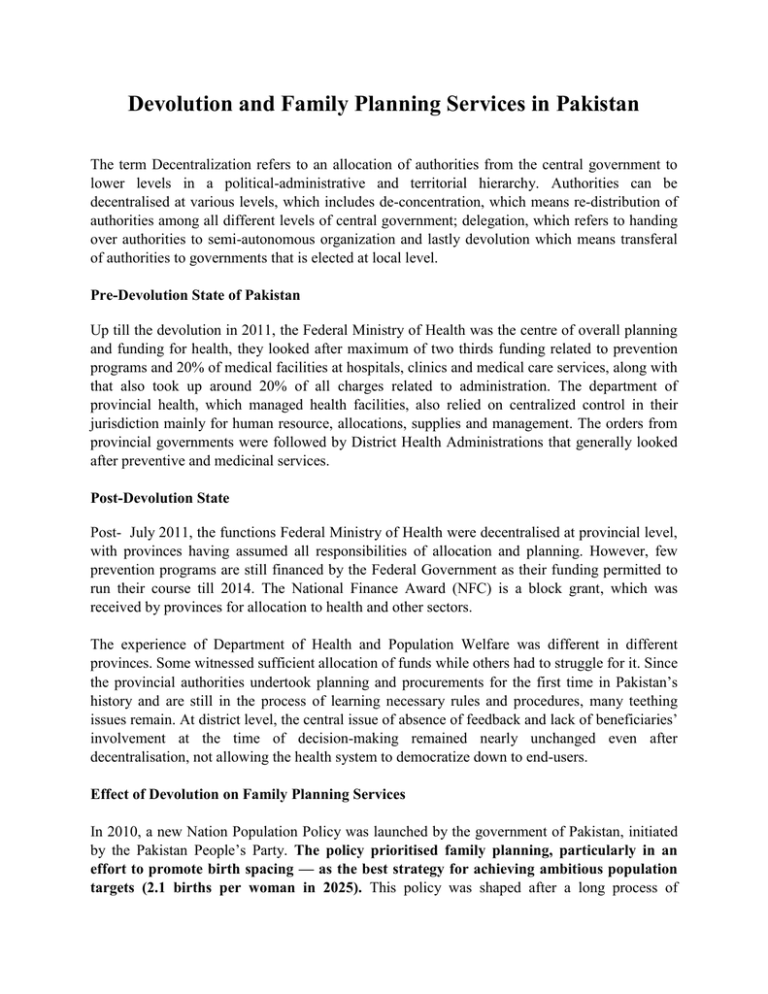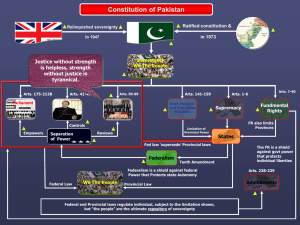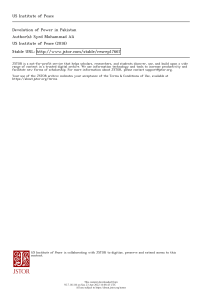Devolution and Family Planning Services in Pakistan
advertisement

Devolution and Family Planning Services in Pakistan The term Decentralization refers to an allocation of authorities from the central government to lower levels in a political-administrative and territorial hierarchy. Authorities can be decentralised at various levels, which includes de-concentration, which means re-distribution of authorities among all different levels of central government; delegation, which refers to handing over authorities to semi-autonomous organization and lastly devolution which means transferal of authorities to governments that is elected at local level. Pre-Devolution State of Pakistan Up till the devolution in 2011, the Federal Ministry of Health was the centre of overall planning and funding for health, they looked after maximum of two thirds funding related to prevention programs and 20% of medical facilities at hospitals, clinics and medical care services, along with that also took up around 20% of all charges related to administration. The department of provincial health, which managed health facilities, also relied on centralized control in their jurisdiction mainly for human resource, allocations, supplies and management. The orders from provincial governments were followed by District Health Administrations that generally looked after preventive and medicinal services. Post-Devolution State Post- July 2011, the functions Federal Ministry of Health were decentralised at provincial level, with provinces having assumed all responsibilities of allocation and planning. However, few prevention programs are still financed by the Federal Government as their funding permitted to run their course till 2014. The National Finance Award (NFC) is a block grant, which was received by provinces for allocation to health and other sectors. The experience of Department of Health and Population Welfare was different in different provinces. Some witnessed sufficient allocation of funds while others had to struggle for it. Since the provincial authorities undertook planning and procurements for the first time in Pakistan’s history and are still in the process of learning necessary rules and procedures, many teething issues remain. At district level, the central issue of absence of feedback and lack of beneficiaries’ involvement at the time of decision-making remained nearly unchanged even after decentralisation, not allowing the health system to democratize down to end-users. Effect of Devolution on Family Planning Services In 2010, a new Nation Population Policy was launched by the government of Pakistan, initiated by the Pakistan People’s Party. The policy prioritised family planning, particularly in an effort to promote birth spacing — as the best strategy for achieving ambitious population targets (2.1 births per woman in 2025). This policy was shaped after a long process of planning and numerous discussions with stakeholders. This was also when the government of Pakistan, introduced a much-delayed decentralization improvement in it functions, with various aspects of governance reallocating authority from the center to provincial level. Thereafter, a strategy was devised for breaking up the Ministry of Population Welfare and decentralising its functions to several other line departments within the provincial government. Regardless of promises related to the advantage of decentralising, the ending of FP services was far from satisfactory. The Planning and Development division of the Federal Government became responsible for planning within health sector, cooperation across provinces and coordinating with donors internationally, where it was meant to be funded by the Population Welfare Program. Presently, four separate ministries with contradictory population planning priorities are dealing with services related to FP and reproductive health, based on provincial need assessments. Among four provinces, there was lack of consensus due to diverging priorities. In Baluchistan, they sought to increase its population so that they can increase the population without paying little consideration to the fact that the province presently has the worst indicators on maternal and infant mortality in the country. Their new population plan encourages couples to have 3 or even 4 children. In Khyber Pakhtunkhwa they seem to be less public or open regarding the issue in order to avoid a conservative religious backlash. Meanwhile, Sindh and Punjab both announced their plans to develop programs regarding FP and reproductive health but yet to take any concrete measures in this regard. As different ministries like health and population got involved in developing policies for FP and RH, the short-term impact of bureaucracy within the policy slowed down its efforts. Alongside this, those responsible for population planning policies were largely unaware of practical issues people faced regarding reproductive health and also exhibited a lack of commitment required for implementation. Similarly, another significant issue has been the lack of willingness towards improving the Lady Health Workers (LHW) program. The LHW programme was initiated in 1994 by the then Prime Minister Benazir Bhutto and their mandate was to provide primary health care services to the residents of rural and urban slums. The Government, despite initiating this program, was slow to regularize the workforce of LHWs who were mainly women, cracked down on them for demanding better pay and further involved them in immunization campaigns for polio, undermining the work already assigned to them. The lack of a centralized policy has resulted in hundreds of women dying in Pakistan due to maternity issues rather than any diseases. Due to lack of autonomy in regards to choice and access majority of the women end up having untimed or unwanted pregnancy which gets terminated at the hands of un-trained practioners and providers risking the lives of these women. Performance of supply side has been insufficient, inappropriate and disorganized which is very much visible today in form of poor indicators of FP that includes TFR, Growth rate, CYP, CPR and efficient methods of birth spacing. Governance Issues after Devolution requiring Improvements 1. Input based Programming- Nearly all programming is centered on inputs with little connection to health outcomes (some outputs), consequently programs eventually correspond with the needs of target beneficiaries or show poor results. 2. Central Planning- At the Provincial Government level the overall human resource management, planning and fund allocation remains centralized, despite the recent devolution. Officials at district level who are the implementers have no authority to modify their budget according to their needs. 3. Weak Monitoring – The system at present does not analyze the data coming from the field. The data received from different monitoring and evaluation visits are never utilized for future planning. 4. Recruitment of the staff is not on merit resulting in low performance levels. Conclusion: The debate on decentralization of country like Pakistan has raised a variety of important concerns for the health system. It is very clear that decentralization is a significant step towards improvement but it has produced several problems that highlight the need for some centralized support to counter national health issues. There is no decentralization that is to idealize and for each country there is a need for selecting a model that is most suitable and politically reasonable for its situation. If at federal level, the central health and population ministries are well-structured with regard to clearly defined roles and accountability mechanisms along with increased inter-departmental coordination and removal of redundancies then only can they serve to facilitate both national and provincial health, population and human rights interests.





